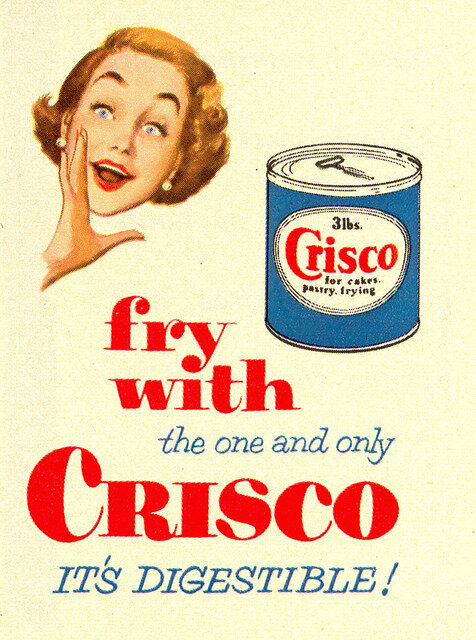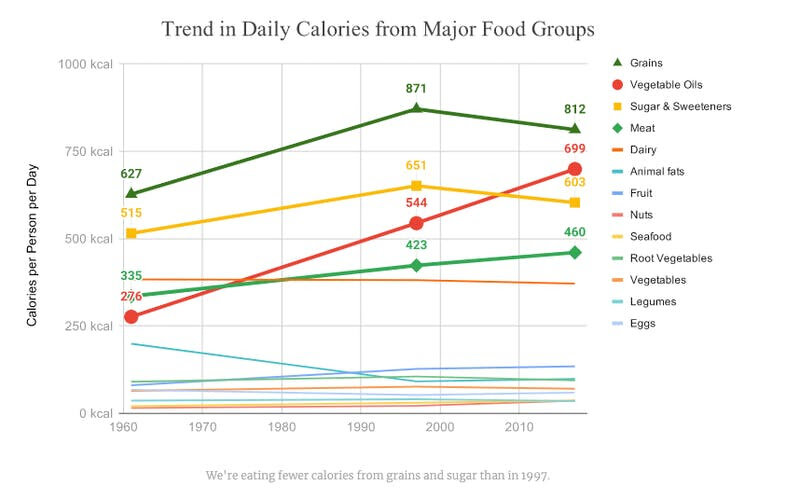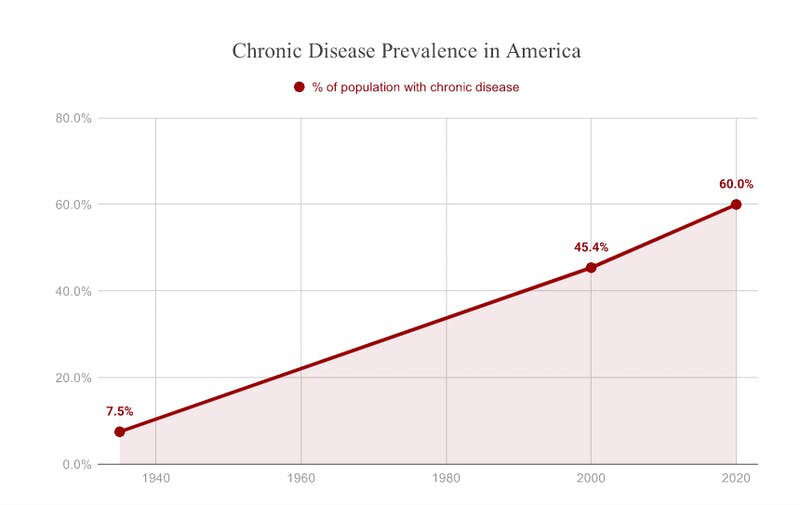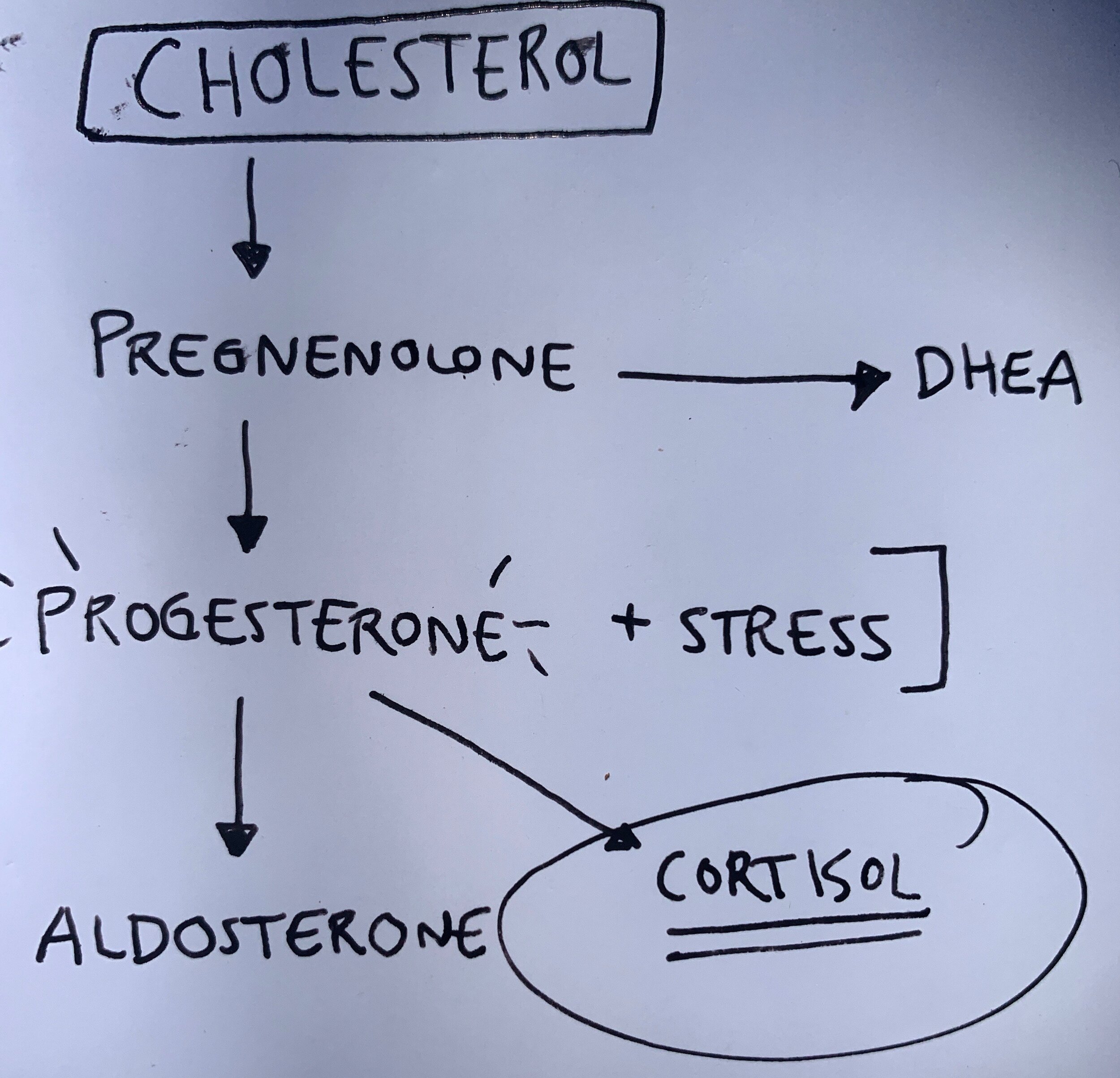Some questions to consider:
-
What if everything we thought we knew about “healthy fats” and having high cholesterol is backwards?
-
What if most of the nutritional claims we take to be true are funded by commercial interests and not rooted in what ingredients our cells truly require to thrive?
-
As the war against saturated fats and cholesterol recently softened, a resurgence of butter, eggs, chocolate, coconut oil, and grass-fed meat is pulsing through the wellness sphere, but what is preventing the new data from spreading faster?
DOCTORS & FEAR:
The Scientific Report of the 2015 Dietary Guidelines Committee removed its traditional recommendation to limit dietary cholesterol to 300 mg a day and stated that “cholesterol is not a nutrient of concern for overconsumption” (1).
Yet, even with that nutritional milestone, most doctors still preach the outdated gospel of avoiding saturated fats and loading up our plates with sunflower oil, salmon, nuts, seeds, and green smoothies made with almond mylk.
Despite mounting evidence that vegetable oils rich in linoleic acid and omega-6 fats are quite inflammatory and detrimental to our cellular health and actually may increase the risk of cardiovascular disease, the anti-saturated fat parade continues (2). (Interesting note: linoleic acid seems to activate the spike protein responsible for allowing COVID-19 to replicate within a host. This might explain why those with metabolic disorders who are overweight and have a diet high in linoleic acid might be at greater risk for getting COVID-19. More research needed.)
Western doctors are trained to prescribe a statin when LDL cholesterol levels exceed 200. Doctors might even benefit financially from prescribing these drugs to you. (Sick-care, at its finest.)
Despite evidence suggesting we start eating the way our grandmothers did and acquire the majority of our micronutrients from animal-based sources and fats in the form of saturated, the mongering against animal fats and consuming too much cholesterol continues to infect our choices and compromise collective health.
DIETARY DOGMA:
For the general public following outdated and even corrupt dietary advice, the confusion about what makes certain fats “good” and others “bad” makes it highly difficult to choose which foods to consume.
I've seen even health conscious people choosing to cook with olive oil and buying butter mixed with canola oil because they think it's the healthier option and that it will help them lose weight.
Or, a friend mentions that they're avoiding eggs because high cholesterol runs in the family and their doctor told them to.
With all of the conflicting guidance and marketing, it's not surprising that people experience food related anxiety when it comes to making the “right” choice. The chaos is overwhelming!
ANTI-FOOD PROPAGANDA:
It's difficult to find a food item that has avoided attack in some form.
Starchy vegetables, sugar, eggs, red meat, (perhaps rightfully so) gluten, almond mylk, and even kale: at first celebrated and highly encouraged, then soon slapped off the plate when conflicting studies come into awareness.
Accompanying the attacks on saturated fat and cholesterol came the advice encouraging everyone to eat more polyunsaturated fats instead.
 (3)
(3)
WHAT IS A PUFA?
A polyunsaturated fat (PUFA) is abundant in seeds, fatty fish, nuts, grain-fed animals, and vegetable oils. PUFAs are highly susceptible to oxidation when exposed to heat. (Vitamin E can help mitigate these damaging effects.)
All fats have a temperature at which they oxidize, becoming unstable, rancid, or toxic: PUFAs happen to do so at much lower temperatures, which leads to tissue damage and inflammation when it oxidizes in the cell.
Conversely, saturated fats--like those found in coconut oil, butter, ghee, tallow, and grass-fed meat, and cream--act like antioxidants and slow the rate of lipid peroxidation, therefore protecting tissue from damage. (Can I get three cheers for butter?)
Cholesterol--abundantly found in eggs, full fat dairy, and red meat--can also protect against the damaging effects of PUFAs, sparing DNA damage and helping to maintain the integrity of the cell (8).
CHOLESTEROL CONFUSION:
The outdated but widely spread advice from mainstream diet culture includes:
-
swapping out real butter for canola and vegetable oil spreads
-
avoiding (the most delicious) foods, like cream, eggs, and beef
-
limiting the daily amount of total saturated fat and cholesterol
-
choosing low fat dairy products
-
cutting the fat off of steak or blotting a burger with a paper towel before eating
What the mainstream diet culture forgot to mention:
-
Cholesterol is biosynthesized by all animal cells and is an essential structural component of animal cell membranes: it is in EVERY cell of your body
-
Cholesterol is a precursor to all of your hormones, especially progesterone, which is highly stress-reducing.
-
It's critical to produce vitamin D
-
It's a critical substrate for the production of bile (which helps to break down and emulsify fats in the body).
-
The body makes cholesterol to in order to process inflammation and stressors
-
Fat and cholesterol from grass-fed animals is also loaded with vitamins A, D. E and K in its most bioavailable forms.
The cholesterol-fed rabbit model demonstrates high levels of cholesterol in the blood do not cause heart disease, and can actually be protective when a body is overburdened with inflammation (5).
A striking analysis of previously unpublished data from the Minnesota Coronary Survey of almost 10,ooo subjects, was one of only two double-blind, randomized controlled trials testing the effect of replacing saturated fat with polyunsaturated fat on the development of cardiovascular disease. The results caused jaws to drop, as the analysis provides new and convincing evidence that a diet that replaces saturated fat with polyunsaturated fat nearly doubled the incidence of heart attacks (4).
HIGH CHOLESTEROL MYTHS:
There are myriad studies showing that not only does high cholesterol correlate with a longer lifespan, but that low cholesterol can lead to an earlier death and a greater likelihood of disease:
“A 1992 study of over three hundred fifty thousand men, aged thirty-five to fifty-seven, followed for twelve years, found that higher cholesterol levels were associated with lower death rates; a five-year study published in 1989 found that low cholesterol increases the risk of death by at least 340 percent in elderly women; a twenty-year study published in 2001 found that those with the lowest cholesterol levels have a 35 percent increase in death rates compared to those with the highest cholesterol levels; and a 1998 study found that low cholesterol levels are associated with higher rates of many infectious diseases including hepatitis, appendicitis, digestive and liver infections, kidney and urinary tract infections, venereal disease and musculo-skeletal infections” (6).
But it's not just the older studies that seem to question the common nutritional advice: A groundbreaking meta-analyses published just this month concluded that,
“whole-fat dairy, unprocessed meat, eggs and dark chocolate are saturated fat-rich foods with a complex matrix that are not associated with increased risk of cardiovascular disease. The totality of available evidence does not support further limiting the intake of such foods.”
The article discusses how diets high in saturated fats protect against all cause mortality and limit the likelihood of having a stroke, suggesting an anti-stress effect of saturated effects.
Furthermore, the study acknowledges the nuance behind the size of the LDL particles, stating,
“Although saturated fats increase low-density lipoprotein (LDL)-cholesterol, in most individuals, this is not due to increasing levels of small, dense LDL particles, but rather larger LDL which are much less strongly related to cardiovascular disease risk” (7).
I often notice that people with chronic infections, gut dysbiosis, hypothyroidism, aging, or metabolic issues of all varieties often have elevated cholesterol levels. They almost always have a history of eating large amounts of polyunsaturated fats.
Even the graphs below illustrate a profound connection between dietary PUFA intake and disease, seemingly less driven by grains, sugar, or meat, but actually vegetable oils. Vegetable oil, which now accounts for 20% of our daily calories, may be wreaking havoc within the epidemic of chronic disease:

 (14)
(14)
Some mention how their doctor asked them to avoid eggs, butter, and red meat to manage their “bad” cholesterol.
This faulty advice perpetuates misconceptions about how the cell preferentially functions.
Instead of thanking the cholesterol for buffering the potential damage--even binding to endotoxin to interrupt damage potential--caused by the underlying issues, cholesterol gets attacked: Fingers continue pointing towards cholesterol and animal fats as the villains responsible for heart disease and atherosclerosis. We forget to look at the context of a body managing a significant load of stress or holding a massive load of polyunsaturated fatty acids that might be hampering the system on a completely foundational level.
As a result of cutting out saturated fats, and innocently increasing polyunsaturated fats, nuts, plant-oils and taking statins, people often end up sicker.
The root cause is ignored as the pills are popped!
LDL & HDL: SIZE MATTERS
The common belief is that there is good and bad cholesterol. So-called experts used to preach that HDL takes the "bad" LDL (low density lipoprotein) cholesterol out of your blood and keeps it from building up in your arteries. LDL was labeled “bad cholesterol” because they (mistakenly) thought it lead to the development and build up of plaque on the walls of your arteries (9).
The demonization of LDL obscures the larger picture, hiding the studies (like the meta-analyses previously mentioned) that acknowledge that the size of the LDL particles matter and that cholesterol can have profoundly protective effects.
This Blanket Statement of “Good Vs. Bad” oversimplifies reality. Tribalism has found its way into even nutrition, it seems.
Studies now show that the size of the LDL particle is a predominant factor in the development of atherosclerosis.
Since smaller lipoprotein particles have a greater surface area, they more rapidly degrade when exposed to the oxidative influences in the serum. People with larger LDL particles, however, are actually quite resistant to heart disease, even when their “bad” cholesterol is high (http://raypeat.com/articles/articles/cholesterol-longevity.shtml). The french paradox of health derived from copious butter and cream consumption may be gaining evidence for good cholesterol leading to more resilient states of health.
The helpful mechanism intrinsic to HDL lipoprotein is how it protects against inflammation by binding to bacterial endotoxins, which seems to be the main driver of all chronic disease when such toxins circulates in the bloodstream.
“The rate of cholesterol production, and the amount in circulation, tend to be inversely related to systemic inflammation. All of the types of lipoprotein absorb, bind, and help to eliminate endotoxin, for example.” -Ray Peat, PhD
CHOLESTEROL, ENDOTOXIN, & THYROID CONNECTION:
What we also don't hear much about is how the body wisely increases cholesterol for protection, working in tandem with the thyroid to keep the system in balance.
According to Dr. Ray Peats research:
“Things that increase absorption of endotoxin--exercise, estrogen, ethanol--cause HDL to rise. Chylomicrons and VLDL also absorb, bind, and help to eliminate endotoxins. All sorts of stress and malnutrition increase the tendency of endotoxin to leak into the bloodstream. Thyroid hormone, by increasing the turnover of cholesterol and its conversion into the protective steroids, is a major factor in keeping the inflammatory processes under control” (8).
Christ Masterjohn, PhD, discusses an interesting study with rabbits that further ties in the importance of thyroid function: They found that they seem to develop atherosclerosis when the amount of LDL and related lipoproteins in the blood greatly exceeds the capacity of LDL receptors to clear it. Rabbits with genetically defective LDL receptors demonstrate a very similar presentation (10). However, adequate thyroid hormone was able to reverse the disease by orchestrating the activity of the LDL receptor (12).
Yet again, the function of the thyroid seems to lead the system towards health or towards disease. When it's functioning robustly, the cells seem to act in ways that out-perform the development of any impairment.
-
Could it be that what experts have blamed as “bad” LDL could in fact be a sluggish thyroid or a condition (even emotional stress or magnesium deficiency) blocking the thyroid's activity, which therefore impairs LDL receptors ability to carry out their jobs?
-
Could there be interference from PUFAs and high levels of FFA interrupting energy production, when studies have myopically blamed saturated fatty acids?
ABSORPTION & CO-FACTORS:
I like to imagine every serving of grass-fed beef and liver as a pre-digested salad.
Thanks to the work of the cows impressive digestive systems, the nutrients from the green grass are bio-available and ready to protect each cell with saturated fat and cholesterol. These substrates are molded as needed by active thyroid (T3) to create protective hormones to mitigate the effects of cortisol, estrogen, serotonin, and the other pro-inflammatory compounds that weasel their way into circulation.
I also appreciate the idea of absorbing a massive dose of nutrition (e.g. vitamin K, choline, and biotin) without any of the anti-nutrients (phytates, lectins, oxalates, gluten, saponins, fermentable fibers) so common in plant-based foods, in something as simple and delicious as a pasture-raised egg.
Vitamin K, concentrated in the yolk and in aged cheese is highly protective against heart disease: The Rotterdam Study followed just under 5,000 people from 1990 to 2000 and found that people who had the highest intakes of vitamin K2 had the lowest risk of arterial calcification and were the least likely to suffer or die from a heart attack (11).
Ironic, isn't it, that eggs and dairy ranks as the two most vilified foods when it comes to ideas about cholesterol clogging the arteries? (No surprise, as nutrition is political. Just follow the money.)
CHOLESTEROL AS A PROTECTIVE FORCE
Stress wastes our magnesium reserves as the body attempts to detoxify the inflammation worsened by cortisol, adrenalin, and the surge of free-radicals that causes oxidative stress.
"One of the basic functions of cholesterol seems to be the stabilization of mitochondria, preventing their destruction by stress. Serious stress lowers ATP, magnesium, and carbon dioxide. When ATP and intracellular magnesium are decreased, cholesterol synthesis increases." -Dr. Ray Peat
Stress influences how our body uses cholesterol

When there is not enough cholesterol available to complete the steroid pathway to make the necessary hormones, your body will most likely prioritize completing the cortisol pathway to manage the stress the body is under (this phenomenon is commonly, but misleadingly, referred to as the “cortisol steal.” It's not stealing anything, just diverting resources to what has been labeled top priority.)
For anyone living a human life, ripe with daily stressors, schedules, toxins, alerts, lights, wifi, murders, a corrupt government and trauma-infused society, a meaningless job, a loss of job, dietary deficits, chronic disability, or facing daily assaults from the food and water ingested, the factors can easily tip the system towards increasing constant, internal stress further.
Seemingly, cholesterol regally glides in during stressful moments to help us out (supporting the synthesis of the protective hormones like pregnenolone, progesterone, and DHEA), acting akin to a safety blanket to buffer the bumps.
The body correctly reads a stressor and increases its ability to respond. These protective hormones can help balance out the harmful effects of more destructive compounds , such as cortisol, adrenalin, and estrogen.
Cholesterol keeps our cells going in the efficient, energy-producing, stress-reducing direction.

(13)
May this serve as a gentle reminder to stay up to date on the studies but even more needed, to question the claims that are often fueled by commercial interests and biased science.
Most importantly, notice how certain foods make you feel and how they impact your digestion, energy, libido, sleep, creativity, and mood. Emphasize whole foods, animal-based nutrition, and vitamins and minerals from grass-fed sources versus plant-based sources to maximize nutrient absorption.
If all of this still sounds overwhelming, confusing, anxiety-producing, or just a little too complicated, feel free to reach out with questions.
The path forward might just be a little simpler and a little more delicious than you previously realized!
In the meantime, slather on the butter, indulge in your chocolate, mix cream in your coffee, and luxuriate in the best cuts of grass-fed meats you can find, while saying no thank you to vegetable oils at all cost.
References:
[1]
- http://health.gov/dietaryguidelines/2015-scientific-report/pdfs/scientific-report-of-the-2015-dietary-guidelines-advisory-committee.pdf [2]
- https://openheart.bmj.com/content/5/2/e000898 [3] https://klappersacks.tumblr.com/post/111559857556/1952-file-photo-digital-archive-on-flickr) [4]
- https://www.westonaprice.org/health-topics/dietary-guidelines-from-the-usda/cholesterol-consensus-crumbles-stance-saturated-fat-softens/ [5]
- https://pubmed.ncbi.nlm.nih.gov/6306464/ [6]
- https://www.westonaprice.org/book-reviews/low-cholesterol-leads-to-an-early-death/ [7]
- https://www.sciencedirect.com/science/article/pii/S0735109720356874 [8]
- http://raypeat.com/articles/articles/cholesterol-longevity.shtml [9]
- https://www.health.harvard.edu/blog/understanding-cholesterol-hdl-vs-ldl-2018041213608 [10]
- https://www.ncbi.nlm.nih.gov/pubmed/6306464 [11]
- https://chrismasterjohnphd.com/blog/2005/07/01/the-incredible-edible-egg-yolk [12]
- https://chrismasterjohnphd.com/blog/2011/03/14/genes-ldl-cholesterol-levels-and [13] https://pubmed.ncbi.nlm.nih.gov/22443975/
[14]https://www.jeffnobbs.com/posts/what-causes-chronic-disease
